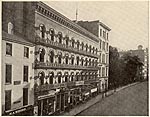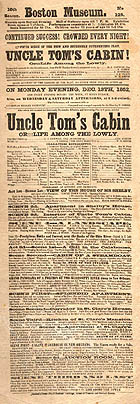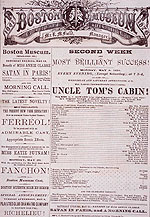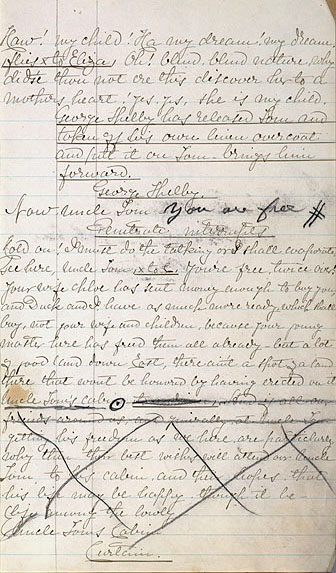

   ENLARGE THIS IMAGE |
Henry J. Conway wrote a number of plays for the Boston Museum. His dramatization of Stowe's novel began running at that theater
in November, 1852 -- less than two months after Aiken's version first appeared
on stage in Troy, New York. In November, 1853, four months after the Aiken
company moved to Manhattan and began its phenomenal run at the National Theatre,
P. T. Barnum brought Conway's version to his American Museum, where for several
months it competed nightly with the show at the National. Conway's version was also very popular with audiences, both in Boston (where it played for over 200 nights) and in New York. As you can see in the archive's REVIEWS SECTION, Boston critics attacked it as both too much like a minstrel show and too unfair to the slave-holding South. When it opened at Barnum's, the Tribune condemned it as "a mere burlesque negro performance" that made a travesty of Stowe's moral argument; in response to this charge, Barnum apparently made some revisions in the script, especially in the auction scene in Act 4. Aiken's treatment soon became the definitive one, but the Boston Museum continued to use the Conway text in its many revivals of Uncle Tom's Cabin at least through the 1870s. In fact, the text available here -- the first time the Conway version has ever been published -- has been recovered from a manuscript promptbook used in an 1876 Museum production. The last 4 scenes of Act 3 of Conway's text are missing: because the part of Topsy was being played by Mrs. G. C. Howard (who played Topsy thousands of times between 1852 and 1880 using the Aiken text), the published Aiken text replaces the handwritten Conway text after Act 3, Scene 3, through the end of an interpolated Act 4 (which is why the promptbook play has 6 acts, while the Conway play had 5). Other than those 4 scenes, the text here seems to follow the original one closely, if not exactly. Because Conway's text was never published, and no other manuscript version of it is known to survive, it's impossible to say exactly what lines or pieces of stage business might have been dropped between 1852 and 1876, but if you compare this text to the scenarios published in various 1852 BOSTON MUSEUM PLAYBILLS, you can see how closely they resemble each other. Some striking features of Conway's dramatization include: the interpolation of a new character named Penetrate Partyside into Stowe's story (played by William Warren for over 25 years, he was a favorite with Museum audiences); in Act 1, the use of "dogs" in the scene of Eliza crossing the river -- audiences couldn't see the dogs, but heard actors offstage barking (there were no dogs in Stowe or Aiken, though within 20 years the "bloodhounds" would become a main attraction of the "Tom Shows"); in Act 2, an elaborate panorama of the Mississippi and other theatrical effects intended to give audiences a sense of riverboat travel; in Act 3, a surprisingly literate Tom, who not only reads Chloe's letter from home, but effortlessly recognizes and corrects her malapropisms; considerably more singing and dancing by slaves: the play opens with an extravagant musical number, and the auction scenes in Act 4 include a "Plantation Jig" danced to a banjo. Because the second half of Act 3 is missing, it can't be said definitively, but one major departure from the novel is that apparently in this script Eva does not die (see the playbill's summary of "Act 3rd"). But to contemporary reviewers, Conway's most striking revision is to have Tom rescued in Act 5 by George Shelby rather than die at Legree's hands. To the New York Tribune and other critics, this happy ending drained the story of its anti-slavery force, but at the same time, the very ending of the play suggests not only that a freed Tom will be welcome to build a new cabin for himself and Chloe in New England, but also seems to expect audiences to commit themselves (in something like the spirit of a revival meeting) to the cause of abolitionism. The promptbook is in The Howard Collection, Performing Arts Collection, The Harry Ransom Humanities Research Center at The University of Texas, Austin, and is reproduced here with their permission. You can see a digital version of the whole promptbook -- including the Aiken interpolations and the 1876 stage manager's cues, etc. -- by CLICKING HERE. The links below are to the portions of the promptbook that can be identified as belonging to Conway's dramatization. |
 Last page of 1876 Promptbook Courtesy Harry Ransome Humanities Research Center |
Scene 1: Shelby Plantation|Uncle Tom's Cabin SONG: Early in De Morning Scene 2: Room in Shelby Plantation House Scene 3: Interior of Uncle Tom's Cabin Scene 4: A Wood or Rocky Pass Scene 5: Roadside Inn Scene 6: Rocky Pass Scene 7: Mountain Pass with Torrent Scene 1: Negro Jail in New Orleans Scene 2: On Board a Mississippi Steamboat Scene 3: Deck of the Steamboat Scene 4: Same as Scene 2 Scene 5: [Panorama of River] Scene 6: Same as Scene 2 Scene 1: Room in St. Clare's Mansion Scene 2: Another Room in St. Clare's SONG: Our Homestead Is Surely the Sweetest on Earth" Scene 3: Same as Scene 1 Scene 1: Slave Warehouse in New Orleans Scene 2: Room in Legree's Plantation House Scene 3: The Auction Mart Scene 1: Penetrate's Hotel Room Scene 2: Same as Act IV, Scene 2 Scene 3: Courtyard of Legree's House |
